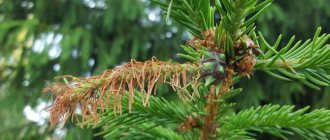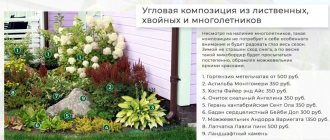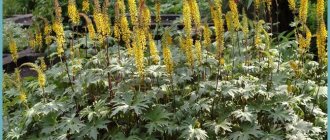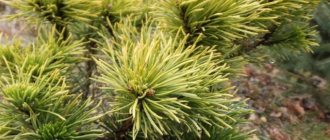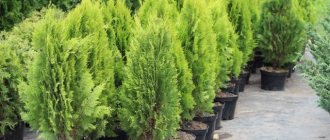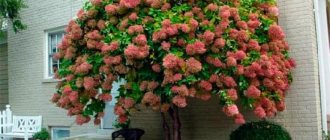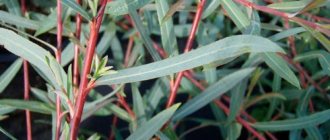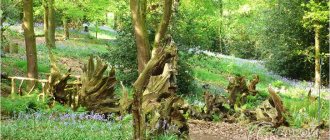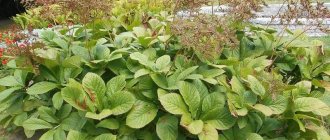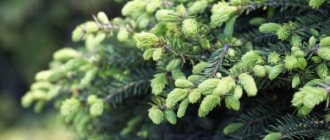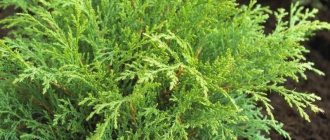- Scheme options
- Scheme options
- Scheme options
- Scheme options
- Scheme options
- Scheme option
Coniferous trees on the site look attractive, especially if they are decorated compositionally. A flowerbed of conifers is suitable for summer residents who rarely visit their garden plot. Evergreen shrubs are unpretentious. At the same time, they are long-lived. For gardeners who are constantly in the garden, a flower bed with conifers and flowers is suitable. Ornamental green plants look impressive together with bright roses and other perennials.
Basics of Landscape Architecture
Not every person can hire a designer who will competently design a garden. However, even a novice gardener can take care of the aesthetic appearance of the site. In order to independently make the territory harmonious and landscaped, you need to know the main points of landscape architecture. Among them:
- Simplicity and unity;
- Proportionality;
- Balance and repetition;
- Symmetry.
Simplicity and unity
Garden design should be light and unobtrusive. The more elements and clutter, the messier and more chaotic the territory looks. Noble simplicity saves the budget. For such a garden, unnecessary details and decorations are not needed.
Important! When planning landscaping, you should pay attention to the house. In what style the dacha is built, this style should be followed when decorating the garden.
Proportionality
The principle of proportionality states that it is important to pay attention to the size of the garden itself and the compositions inside. The owner of a small house and garden will feel uncomfortable going out into a garden, half of which is occupied by a large sculpture or several large and too tall trees. In this case, the already modest territory is visually reduced.
Balance and repetition
Maintaining balance will help make the garden comfortable. You should not plant a small area with trees around the entire perimeter; the balance here will be disrupted due to the appearance of a closed space. Also, the balance will be disrupted if there is a small fence in the garden along which dwarf bushes are planted. In this case, the owners of the garden will feel uncomfortable, as it will create the feeling that they are on public display. Repetition also affects balance. Balance and structure are created through certain repeating attributes. For example, when decorating a flower garden, stone is used, and exactly the same material decorates the foundation of a building or the border of a path.
Symmetry
The point is not that the halves of the garden should be symmetrical. However, some similarity and proportionality must be observed.
How to correctly compose compositions and select neighbors
Despite the popularity of the idea of using coniferous trees in landscape design, there is no single general opinion regarding their selection and composition. There are hundreds of variations that are used by craftsmen throughout the country. You can create both artificially formed plantings and those that look like in the wild. Therefore, gardeners often find compromises, which allows not only to improve the area, but also to create a natural landscape.
The ideal option is an arrangement in which the coniferous tree looks as if it had grown in nature. Despite this, it is constantly necessary to look after it. Without pruning, it can ruin the appearance of the area. Accordingly, this situation and the variety of options have led to the fact that no strict rules are applied during planning. For example, if you plant two spruce trees away from buildings, they will look restless. But, if you place them at the gate, they will look quite natural.
It should also be remembered that the tree only looks beautiful from the south side. In the north it has fewer and shorter needles. An alternative option for selecting a plant is to choose the one you like best. In this case, care will not only bring beauty to the dacha plot, but will also allow you to spend your free time with benefit, caring for the plantings.
Principles of forming coniferous flower beds
Coniferous flower bed
There are special principles of landscape design that are recommended to be followed when growing coniferous flower beds:
- The principle of proportionality must be observed when arranging coniferous mixborders. Due to their volume, they should be located at a sufficient distance from the residential area and recreation area. It is necessary to approximately find out the possible volume of the composition, and then increase this number by 2. The resulting result is the answer to the question: “at what distance from the house or gazebo should a flower bed with conifers and flowers or a coniferous mixborder be located?”
- A flowerbed with juniper, thuja, fir, and larch will look attractive if there is a pond a few meters from it. Home ponds are often decorated with sedge, fern, astilbe, as well as bushes with variegated leaves called hosta. These plants go perfectly with conifers. Therefore, the pond will look the same with the coniferous flowerbed.
- A flower garden of evergreen shrubs and compact trees is best planted so that it faces the east or west. This way the plants will receive the necessary amount of sunlight, but ultraviolet radiation will not harm them. Plants will always have the opportunity to end up where there is shade.
- The gardener must try to make the residents of the evergreen corner comfortable. Slow plant growth should be taken into account. It is recommended to plant one medium-sized conifer or two dwarfs per square meter. To fill the remaining space before the flowerbed takes on the planned form, planting annuals or greenery with beautiful leaves is suitable.
Flowerbed with peonies
Note! When designing an area next to a mixborder, it is recommended to give preference to an emerald lawn. In this case, the green flower garden will look harmonious, simple and natural.
How to beautifully plant thujas on the site
Thuja is unpretentious and grows in almost any conditions: in well-lit places or partial shade, but does not like very dark and northern places. To grow a fence, use the Columna variety; thujas grow into a beautiful hedge.
The Smaragd variety is also excellent for creating a hedge. The distance when planting each plant is 70 cm. It should be planted a meter or one and a half meters from the fence. In three years, the thuja grows into a tall, beautiful hedge. Thuja western emerald has a regular cone-shaped crown, reaching up to 4-6 meters in height and up to 1.80 in width. This thuja is always evergreen. Grows in any soil, grows best in the sun. The soil should be moist and fertile. Already fertilized seedlings are planted in the ground. Hardy and frost-resistant. The good quality of this variety is that it does not turn yellow.
Thuja is suitable for planting together with roses. But we must take into account the rule of constructing an ensemble. If three elements are involved in planting, then the ensemble should combine no more than two colors. So, the constructed composition will look organic. If there are more colors, then the elements are combined into groups of three with the same colors.
Photo source - russcletta.com. The author is landscape designer from Italy Russ Cletta. Roses are given the foreground, conifers serve as the background.
The use of roses and conifers in landscape design is possible, but a large area must be allocated for this. Due to the extensive root system of both plants, they are planted at a distance of at least one and a half meters - this promotes the further development of the plants. It is recommended to plant thujas in a semi-shaded area, and roses in lighter and more formal areas. The rose will not look great if planted in the shade.
Conifers and perennial flowers for mixborders
The following conifers are suitable for creating an evergreen flower garden:
- Veres (juniper);
- Thuja;
- Fir;
- Dwarf pine;
- Blue spruce;
- Yew, etc.
Veres has many types and varieties. The most suitable types for the garden are Cossack, horizontal, and ordinary. It is better for the gardener to select low-growing and dwarf varieties. For example, the cushion-shaped variety Blue Star (its height is only 10 cm, its diameter grows to 1.7 m, its needles are silver); creeping Blue Carpet (grows up to 70 cm in height, about 1.6 m in diameter, blue needles); Echeniformis (semicircular shrub with gray-blue needles, height 60 cm, crown diameter 90-100 cm), etc.
Thuja is indispensable for mixborders, since its main feature is that its lush crown is easy to trim. Thuja is used to make green figures and various architectural forms. The Danika variety (a dwarf with soft scaly needles) is popular. The Hoseri variety is described as a bush in the form of an emerald ball.
The fir for the composition is selected to be dwarf. For example, the Diamond variety, which is a round compact bush with delicate needles. An adult 10-year-old plant stretches up to 50 cm in height and 50-70 in width. A few more dwarf fir trees: Oberon, Silberlock, Nana (balsam).
Dwarf fir
Among the varieties of dwarf pines, the following stand out: Mugus with flattened branches, Pumilio and Pug, with crowns in the form of a sphere.
Blue spruce can be a wonderful addition to a mixborder. Especially compact varieties are Glauka Globoza, Montgomery, Lucky Strikes, as well as varieties of medium height - Koster, Oldenburg, Edith.
Yew attracts designers with its reddish bark and light green crown. In early summer, the plant produces distinctive scarlet or brick-red berries. All varieties of the crop are poisonous. Designers highlight the varieties Samergold (with golden needles), Elegantissima (with a light green-whitish crown).
Perennial plants for coniferous mixborders are selected with similar preferences for the quality of soil composition. They combine well and take root with coniferous cultures:
- Barberry;
- Dwarf birches;
- Fieldfare;
- Roses;
- Hydrangeas;
- Rhododendrons;
- Heather;
- Erika;
- Thyme;
- Phloxes, etc.
Flowerbed with irises
Flowerbed of coniferous plants
Growing conifers in the form of a flower bed begins with selecting a location and drawing up a plan or diagram. The place should be sunny. The diagram includes the arrangement of plants. To make the evergreen mixborder beautiful, you should make its color scheme restrained.
Despite the fact that all planting material is coniferous crops, each plant has its own color. The garden owner should take this into account and try to ensure that the finished mixborder includes only a few primary colors. You shouldn’t make it “motley”. If three different crops are planted, the flowerbed should be two-color. If you plan to plant 5 or more crops, then the color scheme of the evergreen corner should be three-color.
Another condition for arranging a coniferous area is different forms of shrubs and compact trees. Before starting work, the garden owner develops a flower bed diagram. He selects plants according to his taste, without forgetting the basics of landscape design.
Multi-tiered flower bed
Additional Information. Dwarfs are always planted in the foreground of flower beds. After them comes the second tier, where medium-sized shrubs grow. The third tier consists of short or tall trees.
Scheme options
Minimalistic
Implies the absence of unnecessary details. Consists of 3 plants. The coastal juniper Shlager is planted in the foreground, and the thuja Danika is located nearby. The second plan is framed by mountain Pug pine.
Longline
This corner is formed of three tiers. The first tier is represented by creeping Blue Carpet heather and Nana heather. The second tier consists of Pug pine and Canadian Laurin spruce. The Blue Arrow rock heather is planted in the third tier.
Forest landscape
If you want to have a personal forest corner in your garden, you can make it with the help of larches (for example, varieties Kompakta, Pandula or Kornik), balsam fir Nana, mountain pine (Mugusa or Litomisly), blue spruce Koster. It is recommended to complement the landscape with ferns.
An example of a flower bed made of conifers
Step-by-step guide to creating a flower bed
- The scheme is being worked out.
- The perimeter of the flower bed is decorated with stones, bricks or crushed stone.
- The places where the conifers will be planted are indicated. You should take into account a sufficient distance (50-100 cm) between the bushes.
- Next, holes are dug for each of the plants. The depth depends on the size of the root. Approximately, the pits are 50 cm wide and 50-75 cm deep.
- A drainage of coarse sand is laid out at the bottom. A little soil mixture of peat, garden soil, leaf soil, turf soil, and humus is poured.
- Plants are placed in the holes, the remaining space is filled with soil mixture.
- Next, the root circles are mulched with fallen pine needles.
Caring for coniferous composition
Coniferous trees need to be watered regularly
Despite the fact that evergreen crops are unpretentious and strong, they require care in the first few years after planting. It is necessary to feed them with special mineral fertilizers with salts of humic acids for conifers. Mixtures are sold in stores. At first, it is recommended to place an improvised tent made of stretched gauze over the mixborder. This way you can save the needles from sunburn. It is also required to carry out the following procedures in a timely manner:
- Watering (once every 10-15 days);
- Spraying shoots from a spray bottle with clean water (once every 3-7 days);
- Weed removal;
- Loosening;
- Mulching (sawdust, cones, bark, fallen pine needles are used as mulch);
- Trimming and removing old and dry leaves;
- Preparation for winter (trunk circles are generously covered with peat, leaves, sawdust, pine needles).
A flowerbed of conifers is an evergreen island, thanks to which the air in the garden is purified. The advantage of these compositions is that even a beginner in gardening can create them. Any gardener can come up with his own planting scheme and organize a coniferous corner that will delight his household for decades.
Landscape design is a hobby for most owners of suburban areas. As a result of their efforts, the space that surrounds both expensive country houses and simple small houses is significantly transformed. Today, vegetable gardens, as well as gardens, are slowly losing popularity and are being replaced by lawns, flower beds, flower beds, original plant compositions, which cannot but please the eye, including a combination of coniferous plants and roses.
Content:
If you look at it, flower beds constantly attracted the attention of garden lovers, while conifers were, perhaps, rarely used in landscape design. Recently they have become more and more common. When planting conifers, there is a set of rules that are well known to landscape designers. However, since not all owners of country houses can hire a professional for a lot of money, it is better to remember these rules in order to be able to create real beauty on the territory of your house or cottage with your own hands.
Flowerbed with juniper
If a gardener decides to organize a simple evergreen mixborder, then the landscape designer’s hand will immediately reach out to the junipers. These plants are unpretentious and grow in almost any conditions. In addition, they disinfect the air and smell pleasant. There are a large number of different types and varieties of this crop. Thanks to this, the composition with juniper will look advantageous.
Juniper
Scheme options
Longline
The rocky juniper Skyrocket is planted in the center, and several bushes of the Cossack variegated Variegata are placed nearby. The lower tier is represented by the Blue Chip dwarf.
Tiered with perennial flowers
To create tiers, the varieties of heathers Suetsica, Horstmann, Mint Julep, horizontal Wiltoni, Schlager, Silver Mist, Blue Chip are used. The middle tier will be complemented by hydrangea bushes. The lower tier will be decorated with tulips and daffodils. Planting miniature roses is allowed.
Combination with other plants
Spiraea is a universal plant for garden decoration. It can be used as a single decoration or in compositions with other flowers, bushes and trees. Therefore, at the initial stage of designing a garden plot, it is necessary to think in advance about the location of planting spirea shrubs and the location of other plants.
Did you know? The shade of hydrangea flowers depends on the acidity of the soil and the content of trace elements in it. So, on acidic soils they will be blue, on neutral ones - pink, and on medium-acidic soils - lilac or pink, and on one bush.
With hydrangea
In our latitudes, paniculata and tree hydrangeas have proven themselves well. They withstand frost, are rarely affected by diseases and pests, and are undemanding in care.
With hosta
Hosta can act as a solitaire in the composition, while spirea is used for edge planting; or vice versa, spirea is chosen as a soloist, and shorter hostas are planted as a fence. It all depends on the designer’s preferences, the varieties of a particular plant, its characteristics, etc.
For the composition of hosta with spirea, it is also better to choose low-growing varieties. They can be combined in a checkerboard pattern to create a beautiful border along the garden path, or planted as the edging of a flower bed.
With weigela
The spirea-weigela duet looks great on the site. Varieties with simultaneous flowering will combine especially well. They can be arranged in different ways, it all depends on the size of the plot and the personal preferences of the owner.
Gray spirea can be planted next to low roses, peonies, and carnations. Varieties with yellow foliage perfectly complement red Japanese maples. Bushes of viburnum, lilac or broom go well with white flowers.
This wonderful shrub will help you decorate your garden and make it unique. A landscape designer’s flight of fancy is all you need to create a beautiful garden or summer cottage. Planting spirea as a lawn primrose or creating a picturesque border or hedge is a wonderful choice for elegant decor that is not very difficult to care for.
Flower garden with thujas
The cone-shaped shape of the bright emerald thuja looks impressive. Flower beds with thujas are an excellent solution for decorating a large garden. However, these plants should be carefully looked after, especially if the bushes are less than three years old. The crops are shaded from the scorching sun, mulched with sawdust and pine needles, regularly watered and sprayed with a spray bottle.
Scheme options
Multi-colored tiered composition
The tiered thuja flowerbed includes varieties such as Reingold, Miki, Tiny Tim. Reingold will become the basis of the mixborder. Its shape is conical. The variety grows up to 3 meters in 30 years and has sunny soft needles. It will be perfectly complemented by several bushes of emerald Miki. They grow only up to 80 cm and are shaped like a pyramid. Tiny Tim independently takes the shape of a dense ball, which will become a clear accent in the composition. The lower tier is decorated with phlox and sedum.
spherical composition
A round object always attracts the eye. You can form a spherical composition from thujas. It will include varieties Danika, Teddy, Tim Tim. You can also land Globoza there. The composition can be diluted with aubrieta, bryozoan and a carpet of cotoneaster dummera.
Selection of varieties and shades
We have already talked about shade-tolerant plants. But remember that the ideal option is a bright place where they will be exposed to sunlight for at least three hours a day. There are a huge number of varieties, among which several groups suitable for flower beds can be distinguished: bush, standard, ground cover, hybrid tea.
Climbing varieties can theoretically be used, but they will require support for the branches to cling to. Gardeners recommend choosing several shrubs from each group or color for one bed so that it doesn't look tacky.
- Light flowers look beautiful against dark hedges and walls. Bright - on light. But there are no clear rules and it all depends on the specific situation and your preferences. The main thing is that the plantings do not blend into the background.
- In a small area or along paths, it is better to plant low-growing roses. Especially if the path is curved, small flowers will emphasize the curves.
- When designing a large object, you cannot do without varieties of different heights. The tallest ones are usually located in the center.
- Ground covers are suitable for small areas and slopes.
- Species with large inflorescences can be planted separately; with small ones you will not be able to get a harmonious picture.
Color combinations
A monochrome planting scheme works well with white and pale shades. They can be diluted with rich greens. If this option seems too boring, try using these rules.
- Related colors of exclusively warm or cold tones go well together.
- Red inflorescences are diluted with delicate cream, yellow and other pastel palettes.
- Lilac and blue shades are considered universal. They fit into both warm and cold-colored mixborders.
Designers advise choosing varieties that will bloom all summer or combining plants that bloom at different times.
With conifers and stones
Small boulders look impressive together with conifers, so evergreen corners with pebbles, granite, and slate are especially popular among designers.
Example of a flower bed with stones
Scheme options
Stone-forest
It is recommended to select several ground cover varieties of heather for the stones (for example, Wiltoni, golden Golden Carpet or Prince of Wales), Canadian Laurin spruce, Benjamin pine.
Stone with junipers
As planned, the composition will look horizontal. Several cobblestones should be placed randomly. Between them are planted heather varieties Prince of Wales, Gray Owl in the form of a curved tree and cushion-shaped Blue Star.
Floral
Between the stones there will be not only conifers (miniature Mugus pine, Nana heather, golden yew Samergold, golden thuja Yellow Ribbon), but also thyme, barberry, several dwarf birches and pink azalea.
Rectangular high flowerbed with spirea
This type of flower bed can be presented in several variations:
- a high stone container (marble, granite) with sides, inside of which earth is poured and juniper, other conifers and spirea are planted on it;
- a structure made of stone and mesh with an earthen “cushion inside”;
- a classic rectangular flowerbed located on a hill and fenced off by a fence;
- composition along a fence or garden path.
Did you know? The name “spirea” comes from the ancient Greek word “spiral”, because the shoots of the bush naturally twist.
Of course, there are plenty of options. The general rule for all such schemes is that low grades are placed at the edges, higher ones in the depths. This principle also applies to cascading garden design solutions. Varieties of spirea for combination with juniper: Nippon, gray, birch-leaved, Vangutta.
1. Thuja occidentalis “Globosa” 2. Cypress pea 3. Spiraea Boumalda “Froebelli” 4. Scaly juniper “Blue Сarpet” 5. Hybrid iris.
By following the rules for forming flower beds and landscape compositions, you can get a truly spectacular garden decoration. Designers call the best color combinations yellow-green, yellow-white, emerald-lemon, as well as combinations of pine needles with red, purple, yellow and orange flowering plants.
Roses and conifers
Roses and conifers in landscape design represent an exquisite combination. The entire color scheme of roses fits perfectly into the emerald green of the conifers. Every gardener can independently come up with a flower garden design.
Roses fit beautifully into coniferous flower beds
Scheme options
Hedge
Roses and conifers in the same flowerbed can create a hedge or border. In this case, the flowerbed is arranged along the paths or fence. Conifers such as juniper, mountain pine, thuja, Canadian or common spruce, etc. are used. Park and remontant roses will complement the picture.
Minimalistic
Hybrid tea varieties of roses, blooming from June to September, look advantageous with western thuja, Cossack juniper, and mountain pine.
Symmetrical composition
Symmetry is created by several pyramid-shaped Canadian spruce trees and dense bushes of polyanthus roses.
Note! Despite the ideal visual combination of coniferous bushes and roses, the gardener must follow the rules for planting these crops. To prevent roses from picking up rust from evergreens, flowers are planted at a distance of 40-70 cm from conifers.
Planting patterns: a few examples
There are a great many examples of successful coniferous flower beds. We offer you several of our own unique examples to illustrate everything that has been said above. You can safely use them when planning and developing the landscape design of your dacha.
Scheme one
To implement this scheme, you will need either a flowerbed that is made in the form of a small mound, or a flowerbed that has a lawn. Choose one of the two voiced options. To implement the plan, purchase dwarf or low-growing varieties of conifers. And to decorate the soil, use bark or pebbles (or any other decorative stones).
- We plant a cedar pine tree in the conditional center of the composition, which is shifted slightly to the left. For ease of perception, we present the composition itself in the form of a square.
- We plant varietal pine Pinus sylvestris in the upper right corner.
- We fill the lower right corner (the space between two pines) with junipers of the Tamariscifolia variety, of which we will need three.
- In the upper left corner we plant thuja variety Selena. At the same time, we fill in the bald spot that appears at the top between the thuja and the Pinus sylvestris pine with a similar varietal representative. We also plant thuja Selena under its brother, which is located in the upper left corner.
- Just below this specimen we plant one under one Globosa thuja.
- We fill the two remaining free spaces in the lower left corner of the imaginary square with two copies of the Tsuga Canadensis variety.
Scheme two
Guided by this scheme, you can create not just a beautiful planting of coniferous trees. You can create an amazing mixborder in which roses will be solitaires and full-fledged participants in the composition, just like the evergreens in the previous example.
Creating a mixed border flower bed with the participation of conifers and roses is divided into three stages of equal importance.
- The first stage: planting voluminous flora representatives that serve as background.
- Second stage: planting tall representatives of the flora.
- Third stage: planting representatives of the flora that do not have lush foliage.
When all three stages are completed, you can safely plant ground cover varietal rose bushes in the mixborder, followed by planting annual plants. The soil, which will remain bare after all the work done, should be covered with decorative elements. For example, pebbles. Or sprinkled with bark, which will simultaneously serve as mulch, that is, it will protect the mixborder from rapid evaporation of moisture.
An example of the composition described above may be as follows. We ask you in advance to imagine the mixborder in the form of a rectangle so that the arrangement of plants will be more clear to you.
- In the left center we plant roses of the Lady Emma Hamilton variety.
- We plant roses of the Molineux variety in the right center.
- We place juniper above them in the center.
- We plant decorative hosta under them.
- To the side of the varietal rose “Lady Hamilton” we plant white roses of the Winchester Cathedral variety in the upper left corner.
- We plant sage immediately below them. We plant the same sage bush exactly opposite - along the right edge of the mixborder.
- The upper right corner of the mixborder is occupied by the William Shakespeare rose.
In this case, juniper does an excellent job as a background that emphasizes the variety of yellow, scarlet, crimson and snow-white roses. By the way, about yellow and white flowers: it is for them that there is sage in the mixborder. This plant perfectly shades them and does not allow them to get lost against the background of their brighter “sisters”. As a counterbalance to juniper, we suggest planting hosta along the edge of the mixborder, which will complement the flower garden with the required amount of greenery.
Round flowerbed with conifers and perennials
A flowerbed with conifers and perennials in the form of a circle has many variations. However, it is best if the most dwarf plants are located along the edge of the circle; then medium-sized crops can be planted; the center of the round flowerbed is filled with tall evergreen specimens.
Scheme option
The edges of the circle are filled with the cushion-shaped heather variety Blue Star. Greens are supplemented with phlox, thyme or aubrieta, and violets. Next comes a layer of horizontal juniper, barberry and mountain pines. The center of the composition is the Japanese larch Stif Viper and climbing roses on a curved trellis.
Is it possible to plant roses between thujas along the fence?
Photo source - davesgarden.com, rose variety - "Iceberg". An example of a very beautiful successful combination of roses and thujas along the fence.
First of all, the rule is that coniferous trees should be planted at a distance of 1.5 meters from the fence, since when they grow, they can damage the installed fence. Developing a composition where thujas and roses are combined looks very beautiful, but requires constant care. Plants must be pruned in a timely manner and their growth monitored.
When planting, thujas are planted closer to the fence (albeit at an acceptable distance), since they create the main fence, and roses are planted at a distance of one and a half meters in another trench. For planting, it is advisable to use ready-made, proven seedlings. The next rule is timely watering so that the root system is established and does not dry out. When composing the composition, you can plant tea roses, although in both of our examples we used varieties of climbing roses and planted them in the background.
Photo from the site zs-z.ru. A climbing rose is planted along the fence, a thuja is planted at a distance of a meter and a hosta is planted below, which completes and shades the composition.
